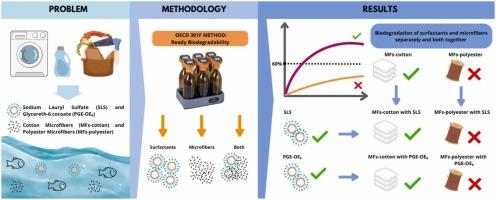Joint aerobic biodegradation of synthetic and natural textile microfibers and laundry surfactants
IF 12.2
1区 环境科学与生态学
Q1 ENGINEERING, ENVIRONMENTAL
引用次数: 0
Abstract
Microfibers (MFs) represent one of the most prominent sources of microplastics in aquatic environments, primarily released during textile washing alongside surfactants found in laundry detergents. This study aimed to investigate the biodegradability of natural (cotton) and synthetic (polyester) MFs individually and in combination with two surfactants: sodium lauryl sulfate (SLS, anionic) and polyoxyethylene glycerol ester (PGE-OE6, nonionic). Using the OECD 301 F test, the research assessed biodegradation patterns and environmental interactions. Biodegradation profiles have been fitted to a pseudo first-order kinetic model and to a logistic kinetic model. Results showed that cotton MFs were partially biodegradable, achieving a 74.9 % mineralization, while polyester MFs exhibited no biodegradability. Importantly, when combined with surfactants, the biodegradation of SLS was inhibited by polyester MFs, but cotton MFs enhanced SLS mineralization. Conversely, the combination of cotton MFs with PGE-OE6 slowed the biodegradation of both the surfactant and the MFs, delaying the onset of cotton degradation. However, polyester MFs’ biodegradability remained unaffected by either surfactant. These findings emphasize the need for more comprehensive assessments of how MFs and surfactants interact in real-world environmental matrices, as these interactions can influence their persistence and ecological impact. The study highlights the scientific importance of understanding pollutant interactions to develop more effective environmental monitoring and mitigation strategies.

合成和天然纺织微纤维与洗衣表面活性剂的联合有氧生物降解
微纤维(MFs)是水生环境中微塑料最主要的来源之一,主要是在纺织品洗涤过程中与洗衣粉中的表面活性剂一起释放出来的。本研究旨在调查天然(棉)和合成(涤纶)MFs 单独或与两种表面活性剂(月桂基硫酸钠(SLS,阴离子型)和聚氧乙烯甘油酯(PGE-OE6,非离子型))结合使用时的生物降解性。研究采用 OECD 301 F 试验,对生物降解模式和环境相互作用进行了评估。生物降解曲线与假一阶动力学模型和逻辑动力学模型进行了拟合。结果表明,棉质纤维素具有部分生物降解性,矿化度达到 74.9%,而聚酯纤维素则没有生物降解性。重要的是,当与表面活性剂结合使用时,聚酯 MFs 会抑制 SLS 的生物降解,而棉 MFs 则会促进 SLS 的矿化。相反,棉质 MFs 与 PGE-OE6 结合使用时,表面活性剂和 MFs 的生物降解速度都会减慢,从而推迟棉花降解的开始时间。然而,聚酯中密度纤维的生物降解性仍然不受任何一种表面活性剂的影响。这些发现强调了对中链芳纶和表面活性剂在实际环境基质中如何相互作用进行更全面评估的必要性,因为这些相互作用会影响它们的持久性和对生态的影响。这项研究强调了了解污染物相互作用对制定更有效的环境监测和缓解策略的科学重要性。
本文章由计算机程序翻译,如有差异,请以英文原文为准。
求助全文
约1分钟内获得全文
求助全文
来源期刊

Journal of Hazardous Materials
工程技术-工程:环境
CiteScore
25.40
自引率
5.90%
发文量
3059
审稿时长
58 days
期刊介绍:
The Journal of Hazardous Materials serves as a global platform for promoting cutting-edge research in the field of Environmental Science and Engineering. Our publication features a wide range of articles, including full-length research papers, review articles, and perspectives, with the aim of enhancing our understanding of the dangers and risks associated with various materials concerning public health and the environment. It is important to note that the term "environmental contaminants" refers specifically to substances that pose hazardous effects through contamination, while excluding those that do not have such impacts on the environment or human health. Moreover, we emphasize the distinction between wastes and hazardous materials in order to provide further clarity on the scope of the journal. We have a keen interest in exploring specific compounds and microbial agents that have adverse effects on the environment.
 求助内容:
求助内容: 应助结果提醒方式:
应助结果提醒方式:


